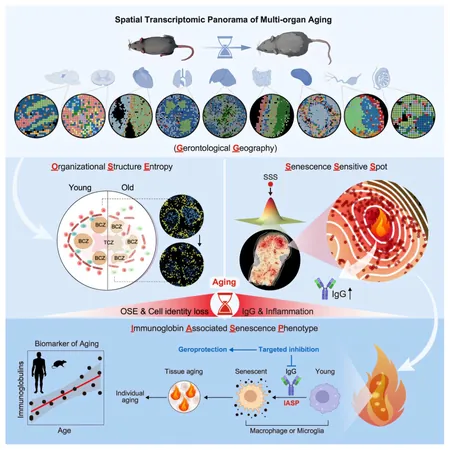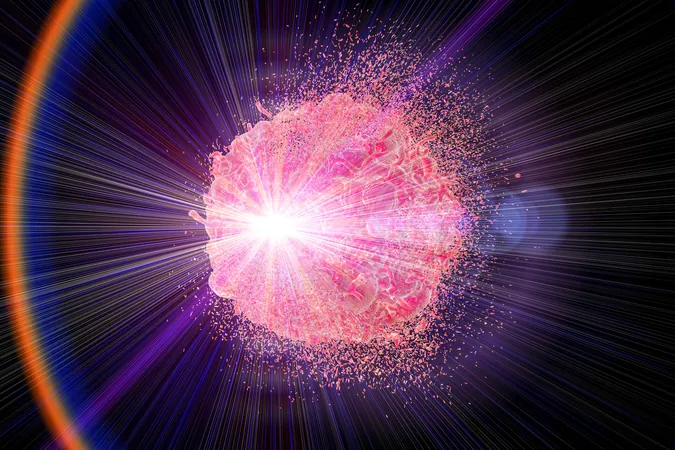
The Hidden Truth About Aging: How Immunoglobulins Can Transform Our Understanding of Old Age
2024-11-10
Author: John Tan
Introduction
In a groundbreaking study, researchers from the Chinese Academy of Sciences (CAS) and BGI Research have revealed the complex relationship between immunoglobulins and the aging process—discoveries that could dramatically change our approach to gerontology.
Publication and Overview
Published in the prestigious journal *Cell* on November 4, this research provides an unprecedented view into how various organs experience aging, creating high-precision maps that reveal both the biological and spatial dimensions of aging.
Research Background
For years, scientists have been on the hunt for systemic biomarkers that drive aging. This study, spearheaded by a collaboration of esteemed teams led by Liu Guanghui and Gu Ying, among others, uncovers vital answers to this persistent mystery. By conducting a meticulous analysis of spatial data across nine different organs in male mice, the researchers crafted detailed spatial transcriptomic maps that highlight over 70 unique cell types—as well as the various aging mechanisms at play.
Gerontological Geography (GG)
This extensive exploration has coined a new term: Gerontological Geography (GG). This concept encapsulates the key indicators of aging, including the disarray within tissue structures and a decline in cellular identity—traits that are now recognized as overriding hallmarks of aging. "Our findings pinpoint the specific areas where aging manifests within multiple organs, unveiling the accumulation of immunoglobulins as a primary driver of this process," stated Professor Liu, one of the study's lead authors.
Organizational Structure Entropy (OSE)
Using a novel analytical approach called Organizational Structure Entropy (OSE), researchers identified that a disrupted spatial organization and loss of cell identity are universal indicators of systemic aging. This suggests that damage to the structural organization of tissues may trigger functional declines in various organs as they age.
Senescence-Sensitive Spots (SSS)
One significant breakthrough was the identification of Senescence-Sensitive Spots (SSS)—specific regions within different tissues that are particularly vulnerable to the aging process. Closer examination revealed that these areas exhibited elevated structural entropy and more profound losses in cellular identity—indicating that SSS could serve as critical epicenters in the aging process.
Role of Immunoglobulins
Most notably, in organs related to the immune system, plasma cells predominated in the SSS microenvironment. These cells, integral to antibody production, showcased increased expression of immunoglobulin-related genes as they neared SSS. Additionally, levels of immunoglobulin G (IgG) escalated in various tissues as subjects aged, hinting at its potential as a new biomarker for aging. Alarmingly, researchers found that IgG can actively promote aging in macrophages and microglia, further releasing inflammatory factors that accelerate cellular decline.
IgG Injection Findings
The shocking revelation? Injecting IgG into younger mice triggered aging processes across multiple tissues.
Antisense Oligonucleotides (ASO) Intervention
In a promising twist, the research team pioneered an intervention leveraging antisense oligonucleotides (ASO) to diminish IgG levels in mouse tissues, yielding delays in the aging process across several organs.
Significance of the Research
This pioneering research is the first of its kind to thoroughly investigate the spatial transcriptome of aging across mammalian systems, revealing structural disruption and cellular identity loss as core aspects of aging while also mapping core regions linked to susceptibility. The introduction of the Immunoglobulin-associated Senescence Phenotype (IASP) marks a monumental advancement in the science of aging, with the potential to reshape future strategies aimed at delaying aging and combatting age-related diseases.
Conclusion
As we stand on the brink of new scientific frontiers, will the secrets unlocked in this study pave the way for breakthroughs in anti-aging therapies? Only time will tell, but the age of understanding immunoglobulins may just begin the next chapter in aging research.


 Brasil (PT)
Brasil (PT)
 Canada (EN)
Canada (EN)
 Chile (ES)
Chile (ES)
 Česko (CS)
Česko (CS)
 대한민국 (KO)
대한민국 (KO)
 España (ES)
España (ES)
 France (FR)
France (FR)
 Hong Kong (EN)
Hong Kong (EN)
 Italia (IT)
Italia (IT)
 日本 (JA)
日本 (JA)
 Magyarország (HU)
Magyarország (HU)
 Norge (NO)
Norge (NO)
 Polska (PL)
Polska (PL)
 Schweiz (DE)
Schweiz (DE)
 Singapore (EN)
Singapore (EN)
 Sverige (SV)
Sverige (SV)
 Suomi (FI)
Suomi (FI)
 Türkiye (TR)
Türkiye (TR)
 الإمارات العربية المتحدة (AR)
الإمارات العربية المتحدة (AR)